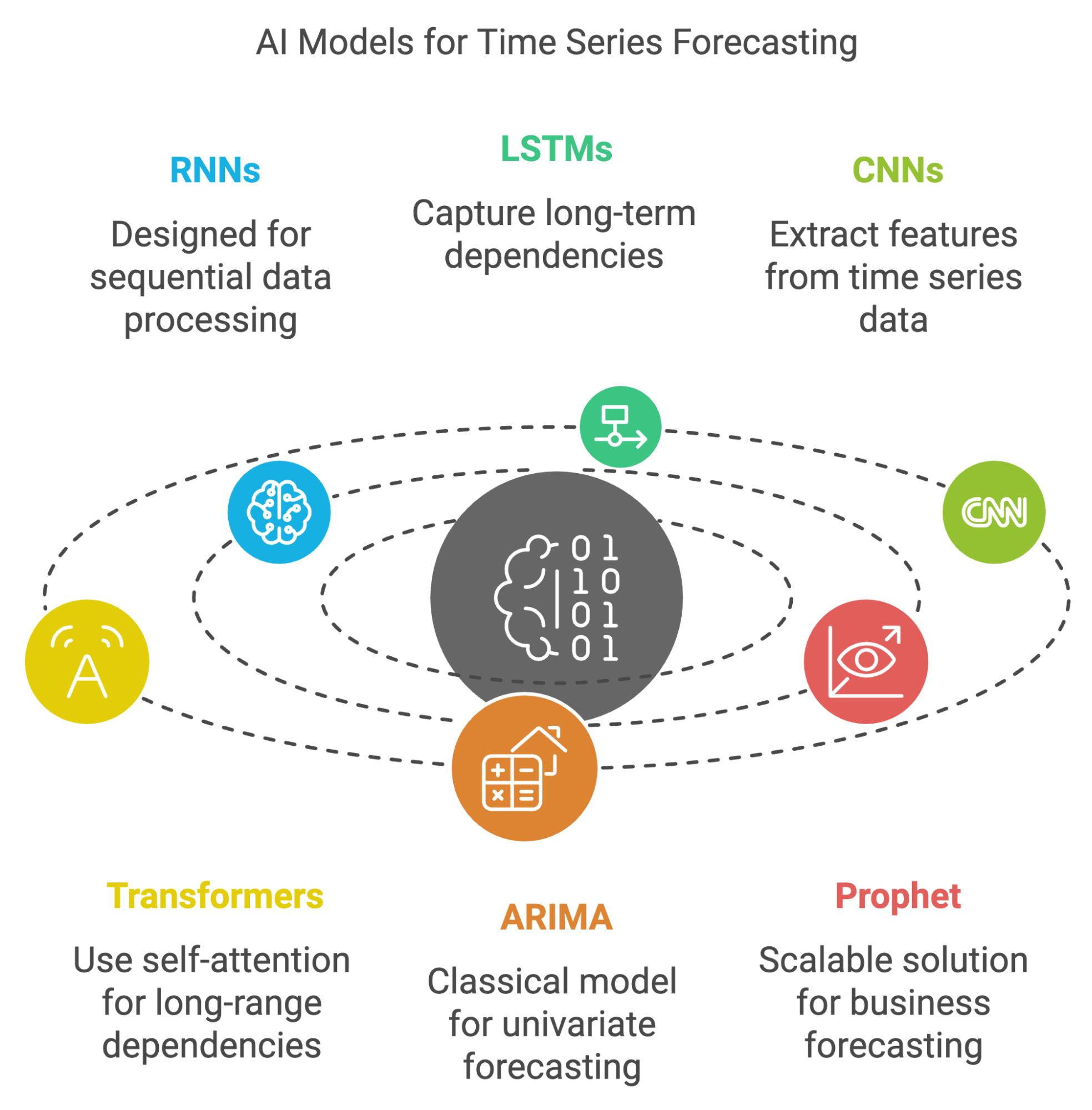Track
Businesses struggle to predict future trends and events based on historical data. Traditional forecasting methods often fail to capture the intricate patterns and complexities of real-world data. These conventional approaches may work well for simple trends but struggle in more complex scenarios.
A potential solution to this is using artificial intelligence. In this blog, I will explain how AI improves time series forecasting through its ability to analyze vast amounts of data, uncover patterns, and incorporate multiple variables.
AI Upskilling for Beginners
What Is Time Series Forecasting?
A time series is a collection of data points recorded at regular intervals over time. Time series forecasting refers to the process of using historical data to predict future values in a sequence of observations.
In finance, for example, forecasting models help predict stock prices and market trends, enabling investors to make informed, timely decisions.
Retail businesses rely on time series forecasting to anticipate customer demand, ensuring that inventory is aligned with expected sales. Similarly, energy companies use these models to forecast consumption patterns, allowing them to manage resources effectively and optimize energy distribution.

How AI Improves Time Series Forecasting
AI models are particularly adept at uncovering hidden relationships in the data, such as seasonal variations, recurring patterns, and subtle correlations, which might be difficult for traditional models to recognize.
Uncovering hidden patterns
One of the standout benefits of AI, especially deep learning architectures such as recurrent neural networks (RNNs) and long short-term memory (LSTM) networks, is their capacity to recognize intricate patterns in time series data. These models can identify seasonal trends, cyclical behaviors, and anomalies that may otherwise be difficult to detect.
For example, while conventional approaches may rely on predefined assumptions about seasonality or trend direction, AI models dynamically learn from the data itself, discovering hidden relationships between variables, and leading to more precise forecasting.
Adaptability
Another key advantage of AI in time series forecasting is its ability to adapt. Unlike models that may require reconfiguration when new data or trends emerge, AI models can be continuously trained and updated as data becomes available.
This adaptability makes AI especially useful in fast-changing environments where historical trends may not always strongly influence future outcomes. For instance, in the retail sector, an AI system can quickly adjust its predictions for consumer demand based on the latest purchasing behavior or market conditions.
Handling multiple variables
AI's capacity to handle multiple variables simultaneously is a game-changer in forecasting. Traditional forecasting models often focus on a single or limited set of variables, but AI models can process and analyze various external factors—such as economic indicators, weather data, social media sentiment, and even geopolitical events—alongside time series data.
This holistic approach can generate more nuanced and accurate predictions. For example, energy consumption forecasting can benefit from the inclusion of weather patterns, while stock market forecasts may improve by considering macroeconomic trends and industry-specific developments.

AI Models and Algorithms for Time Series Forecasting
AI offers a variety of powerful models and algorithms designed to handle the sequential nature of time series data. Each approach brings unique strengths that are suitable for different forecasting tasks. Here, we present an overview of the most prominent AI models used in time series forecasting.
Recurrent neural networks (RNNs)
Recurrent neural networks (RNNs) are a class of neural networks specifically designed for processing sequential data, making them a natural fit for time series forecasting. Unlike traditional feedforward neural networks, RNNs maintain a memory of previous inputs, which allows them to understand the relationships between data points across time.
This ability to leverage past data is fundamental in time series tasks, where each data point depends on previous observations. However, standard RNNs can struggle with long-term dependencies due to the vanishing gradient problem, which limits their effectiveness in handling very long sequences.
Long short-term memory (LSTM)
Long short-term memory networks are a specialized type of RNN designed to address the limitations of standard RNNs. LSTMs excel at capturing long-term dependencies in time series data by using a series of gates that control the flow of information.
This architecture allows LSTMs to retain important information over longer periods, making them particularly effective in applications where long-term patterns are paramount, such as predicting stock prices or energy consumption trends over extended periods. By mitigating the vanishing gradient issue, LSTMs can model both short-term fluctuations and long-term trends with greater accuracy.
Convolutional neural networks (CNNs)
While typically associated with image processing, convolutional neural networks have been successfully adapted for time series forecasting. CNNs can extract meaningful features from time series data, particularly when spatial or temporal patterns are present.
By applying convolutional filters, these models can detect local trends and periodic behaviors within a time series. For instance, CNNs are useful in scenarios where the time series data exhibits spatial relationships, such as in energy consumption across regions or in the case of multivariate time series, where interactions between different variables need to be captured.
Transformers
Transformers have recently gained significant attention in natural language processing (NLP), but their potential for time series forecasting is equally promising. The key innovation in transformer models is the use of self-attention mechanisms, which allow the model to weigh the importance of different time steps without the need for sequential processing.
This capability allows transformers to capture long-range dependencies more efficiently than RNNs or LSTMs, especially when dealing with large datasets. As a result, transformers can excel in tasks that require the model to consider both short-term and long-term trends, such as sales forecasting or weather predictions.
Other models
In addition to deep learning models, other well-established algorithms can be effective for time series forecasting, particularly in simpler cases.
ARIMA (AutoRegressive Integrated Moving Average) is a classical statistical model used for univariate time series forecasting. It’s a solid choice for time series with a clear trend or seasonality but may not handle complex patterns as well as AI models.
Similarly, Prophet, developed by Meta, offers a scalable and interpretable forecasting solution that performs well with missing data and seasonality, making it a popular tool for business forecasting with time series data.

Getting Started with AI for Time Series Forecasting
Implementing AI for time series forecasting involves several steps, from data preparation to deploying the model in a production environment.
Step 1: Data collection and preprocessing
The foundation of any successful AI model is high-quality data. For time series forecasting, clean, well-structured data is necessary. This involves gathering relevant time series data, which might include not just historical records but also external variables like weather, economic indicators, or customer behavior, depending on the use case.
Preprocessing is equally important, as time series data often contains missing values, noise, or outliers. Techniques like interpolation for missing data, smoothing for noise reduction, and feature scaling are essential steps in ensuring that the data fed into the model is robust and reliable.
Step 2: Choosing the right model
Selecting the appropriate AI model for time series forecasting depends on multiple factors. These include the complexity of the dataset, the required level of interpretability, and the specific forecasting task at hand. Traditional models like ARIMA or Prophet might be sufficient for simpler datasets with clear trends and seasonality.
However, for more complex, multivariate datasets or cases where long-term dependencies are important, deep learning models like LSTM or transformers may be more suitable.
We must also balance accuracy and interpretability—while more complex models like deep learning architectures may offer higher accuracy, simpler models can provide clearer insights into the relationships between variables.
Step 3: Training and evaluation
The next step is training it on historical time series data. During this process, the model's parameters are adjusted to minimize errors in its predictions. To ensure the model performs well on new data, the dataset is typically divided into training, validation, and testing sets. This allows us to assess how the model generalizes beyond the data it was trained on.
A common practice is cross-validation, which evaluates the model’s performance across different data subsets to ensure consistency and reliability. To measure how well the model predicts, we use metrics like mean absolute error (MAE) and root mean squared error (RMSE).
Step 4: Deployment and monitoring
Once we are satisfied with the training and evaluation, our model can be deployed into a production environment where it can generate real-time or batch predictions. However, deployment is not the final step—ongoing monitoring is key to ensure the model continues to perform well as new data becomes available.
Over time, changes in the underlying patterns of the data, known as data drift, can reduce the accuracy of predictions. To address this, regular monitoring and periodic retraining are necessary to keep the model relevant and effective in dynamic environments.
Tools and libraries
We can use the following tools and libraries to develop AI models for time series forecasting:
- TensorFlow and PyTorch: These are the most popular deep learning frameworks, widely used for implementing models like RNNs, LSTMs, CNNs, and transformers.
- Prophet: Developed by Meta, Prophet is a user-friendly library for time series forecasting. It is particularly good at handling missing data, seasonality, and holiday effects, making it ideal for business applications.
- ARIMA and SARIMA: Classical statistical models that are well-suited for simpler, univariate time series forecasting tasks, especially when trends and seasonality are present.
- GluonTS: A library developed by Amazon for deep learning-based time series forecasting, offering ready-made models and tools for quick deployment.
- Statsmodels: A Python library that provides tools for estimating and interpreting traditional time series models like ARIMA.
Real-World Applications of AI in Time Series Forecasting
AI time series forecasting can have an impact on many industries:
- Finance: AI models predict stock prices, assess risks, and detect fraud by analyzing market data.
- Retail: AI helps forecast demand, optimize inventory, and predict sales to improve operations.
- Energy: AI models forecast load and renewable energy production, optimizing resource allocation.
- Healthcare: AI aids in patient monitoring, disease outbreak prediction, and resource allocation.
- Supply chain: AI enables efficient inventory planning, demand forecasting, and logistics optimization.
- Other fields: AI is used in weather forecasting, transportation planning, and environmental monitoring.

Conclusion
In this blog, we've explored AI's transformative impact on time series forecasting. AI's ability to uncover hidden patterns, adapt to changing trends, and incorporate multiple variables has improved predictions.
To learn more about AI and time series forecasting, I recommend these resources:




